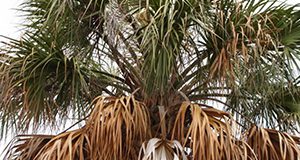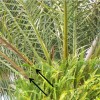
Texas Phoenix palm decline is a new disease in Florida, caused by an unculturable bacterium. It is a fatal, systemic disease that kills palms relatively quickly. This six-page fact sheet explains the pathogen and hosts of TPPD, its symptoms, how to diagnose it, and provides disease management practices. Written by Nigel A. Harrison and Monica L. Elliott and published by the Plant Pathology Department.
http://edis.ifas.ufl.edu/pp163
Tag: Monica L. Elliott
Calonectria (Cylindrocladium) Leaf Spot of Palm (PP302)
 Calonectria is a fungus that affects a large number of hosts worldwide, including timber and ornamental, agricultural, and horticultural crops, causing a wide range of disease symptoms, such as cutting rot, damping-off of seedlings, leaf spot, shoot blight, and root rot. This 4-page fact sheet was written by Jiaming Yu and Monica L. Elliott, and published by the UF Department of Plant Pathology, January 2013.
Calonectria is a fungus that affects a large number of hosts worldwide, including timber and ornamental, agricultural, and horticultural crops, causing a wide range of disease symptoms, such as cutting rot, damping-off of seedlings, leaf spot, shoot blight, and root rot. This 4-page fact sheet was written by Jiaming Yu and Monica L. Elliott, and published by the UF Department of Plant Pathology, January 2013.
http://edis.ifas.ufl.edu/pp302
Hurricane-Damaged Palms in the Landscape: Care after the Storm (ENH1204/EP465)
 While many palm species are adapted to windstorms, a hurricane can damage even the most tolerant palms. This 3-page fact sheet provides suggestions about what to do after a windstorm has occurred once it is safe to venture outside to care for the landscape.
While many palm species are adapted to windstorms, a hurricane can damage even the most tolerant palms. This 3-page fact sheet provides suggestions about what to do after a windstorm has occurred once it is safe to venture outside to care for the landscape.
Written by Monica L. Elliott and Timothy Broschat, and published by the UF Department of Environmental Horticulture, September 2012.
http://edis.ifas.ufl.edu/ep465
Fusarium Wilt of Canary Island Date Palm (PP215/PP139)
 As the name implies, Fusarium wilt of Canary Island date palm is primarily observed on the Canary Island date palm. It was first documented in the United States in the 1970s in California, but it was not documented in Florida until 1994. It now occurs throughout the state. The fungus obstructs the xylem (water-conducting) tissue, which results in desiccation and death. This 5-page fact sheet was written by Monica L. Elliott, and published by the UF Department of Plant Pathology, July 2012.
As the name implies, Fusarium wilt of Canary Island date palm is primarily observed on the Canary Island date palm. It was first documented in the United States in the 1970s in California, but it was not documented in Florida until 1994. It now occurs throughout the state. The fungus obstructs the xylem (water-conducting) tissue, which results in desiccation and death. This 5-page fact sheet was written by Monica L. Elliott, and published by the UF Department of Plant Pathology, July 2012.
http://edis.ifas.ufl.edu/pp139
Bud Rot of Palm (PP220/PP144)
 To understand bud rots, an explanation of palm anatomy is necessary. The growing point of the palm is often called the bud or heart. All leaves originate from there, and each palm stem has only one. Thus, when the bud is damaged or diseased, the palm usually dies. The first symptom is discoloration and wilting of the spear leaf and wilting/discoloration of the next youngest leaf. This 4-page fact sheet was written by Monica L. Elliott, and published by the UF Department of Plant Pathology, July 2012.
To understand bud rots, an explanation of palm anatomy is necessary. The growing point of the palm is often called the bud or heart. All leaves originate from there, and each palm stem has only one. Thus, when the bud is damaged or diseased, the palm usually dies. The first symptom is discoloration and wilting of the spear leaf and wilting/discoloration of the next youngest leaf. This 4-page fact sheet was written by Monica L. Elliott, and published by the UF Department of Plant Pathology, July 2012.
http://edis.ifas.ufl.edu/pp144
Brown Patch (SSPLP5/LH044)
Brown patch, large patch, or Rhizoctonia blight is a fungal disease observed November through May that infects the leaf area closest to the soil, eventually killing the leaf. This 3-page fact sheet was written by M. L. Elliott and P. F. Harmon and published by the UF Department of Plant Pathology, February 2011.
http://edis.ifas.ufl.edu/lh044
Take-all Root Rot (SSPLP16/LH079)
Take-all root rot, or Bermudagrass decline, is a root rot disease triggered by high rainfall or stress and manifesting as irregular yellow or light green patches two to three weekds after the pathogen has been active in the roots. This 3-page fact sheet was written by M. L. Elliott and P. F. Harmon and published by the UF Department of Plant Pathology, February 2011.
http://edis.ifas.ufl.edu/lh079
Turfgrass Disease Management (SSPLP14/LH040)
Turfgrass diseases are underappreciated because the biological organisms (plant pathogens) causing the problems are rarely observed. Fortunately, grasses maintained using proper cultural practices (water, mowing, and fertility) are not as likely to become diseased or be as severely damaged as grasses that do not receive proper care. This 11-page fact sheet discusses turfgrass diseases, their causal agents, diagnosis, and management. Written by M. L. Elliott and P. F. Harmon and published by the UF Department of Plant Pathology, February 2011.
http://edis.ifas.ufl.edu/lh040
Cercospora Leaf Spot (SSPLP57/LH082)
Cercospora leaf spot is a fungal disease of St. Augustinegrass observed during periods of frequent rainfall. This revised 2-page fact sheet was written by M. L. Elliott and P. F. Harmon, and published by the UF Department of Plant Pathology, February 2011.
http://edis.ifas.ufl.edu/lh082
Rust (SSPLP12/LH051)
Rust is a fungal disease that occurs in cool weather causing yellow specks enlarging to spots with orange pustules in St. Augustinegrass and zoysiagrass. This revised 2-page fact sheet was written by M. L. Elliott and P. F. Harmon, and published by the UF Department of Plant Pathology, February 2011.
http://edis.ifas.ufl.edu/lh051
Pythium Root Rot (SSPLP11/LH050)
This fungal root disease affecting all warm-season turfgrasses is associated with wet soil conditions causes nonspecific decline in turf quality. This revised 2-page fact sheet was written by M. L. Elliott and P. F. Harmon, and published by the UF Department of Plant Pathology, February 2011.
http://edis.ifas.ufl.edu/lh050
Helminthosporium Leaf Spot (SSPLP9/LH048)
This fungal disease is most serious on bermudagrass and acts over a wide range of temperatures. This 2-page fact sheet was written by M. L. Elliott and P. F. Harmon, and published by the UF Department of Plant Pathology, February 2011.
http://edis.ifas.ufl.edu/lh048
Gray Leaf Spot (SSPLP8/LH047)
This disease affects primarily St. Augustinegrass, but also centipedegrass. It is most often observed from late spring to early fall, especially during prolonged periods of rainfall. This revised 2-page fact sheet was written by M. L. Elliott and P. F. Harmon, and published by the UF Department of Plant Pathology, February 2011.
http://edis.ifas.ufl.edu/lh047
Fairy Rings (SSPLP7/LH046)
Fairy rings, especially the mushrooms, are most commonly observed during the summer months, when Florida receives the majority of its rainfall. This revised 2-page fact sheet with identification and control information was written by M. L. Elliott and P. F. Harmon, and published by the UF Department of Plant Pathology, February 2011.
http://edis.ifas.ufl.edu/lh046
Anthracnose (SSPLP56/LH043)
Identify and control for this disease that often appears as reddish-brown spots surrounded by a narrow yellow halo, primarily in centipedegrass. This revised 2-page fact sheet was written by M. L. Elliott and P. F. Harmon, and published by the UF Department of Plant Pathology, February 2011.
http://edis.ifas.ufl.edu/lh043
PP278 Fusarium Wilt of Queen Palm and Mexican Fan Palm
PP278, a 6-page illustrated fact sheet by Monica L. Elliot, describes this lethal fungal disease affecting primarily queen and Mexican fan palms — pathogen and hosts, symptoms, diagnosis, and disease management. Includes references. Published by the UF Department of Plant Pathology, June 2010.
http://edis.ifas.ufl.edu/pp278
PP-243/PP163 Texas Phoenix Palm Decline
Revised! PP-243, a 5-page illustrated fact-sheet by Nigel A. Harrison and Monica L. Elliott, describes this new systemic disease affecting primarily date palms in Florida, the pathogen and hosts, symptoms, diagnostics, and disease management. Includes references. Published by UF Department of Plant Pathology, February 2009.
http://edis.ifas.ufl.edu/PP163
PP 246/PP166 Palm Problems: Field and Laboratory Diagnosis
PP-246, a 6-page illustrated fact sheet by Monica L. Elliott and Timothy K. Broschat, includes tips to determine when laboratory diagnostics may be useful and how to interpret and/or integrate field and
laboratory diagnoses. Includes references. Published by the UF Department of Plant Pathology, June 2008.
http://edis.ifas.ufl.edu/PP166